“LIFE IS BUT A DREAM” (1894)
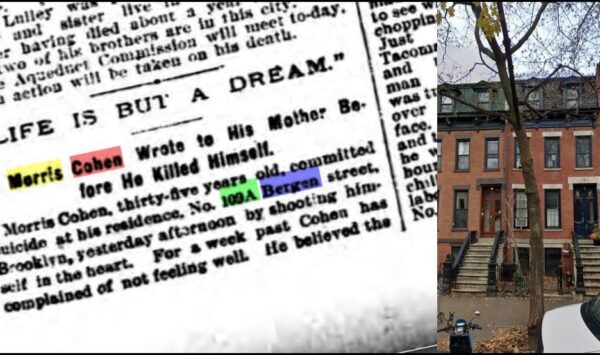
******************************************************************************************************************************** Brownstone Detectives investigates the history of our clients’ homes. The story you are about to read was composed from research conducted in the course of one of those investigations. Do you know the history of YOUR house? ******************************************************************************************************************************** (From The New York Herald, Wed., 7 March 1894.) “LIFE IS BUT A DREAM.” So wrote Morris Cohen to his mother before he killed himself. Morris Cohen, thirty-five years old, committed suicide at his residence, No. 109A Bergen street, Brooklyn, yesterday afternoon by shooting himself in the heart. For a weak past, Cohen has complained of not feeling well. He believed the grip had attacked him. At noon yesterday he returned to his home from his place of business, No. 143 Smith street. He was met at the door by his mother, to who he said that he was going to his room to lie down. He asked her to call him at two o’clocl. At that house his mother went to his room and foudn him on the bed. In his right hand, tightly clutched, was a .38 calibre revolver. His clothing was covered with blood. The suicide had sent but one bullet into his body and this, from all appearances, had caused instant death. On the dressing case in the room was a letter written by Cohen to his mother as follows: “Life is but a dream.” My dream is o’er. I am going crazy to lie in a silent tomb. Dear mother, don’t shed a tear or wear […]
THE FARMS LINES OF BROOKLYN (1874)
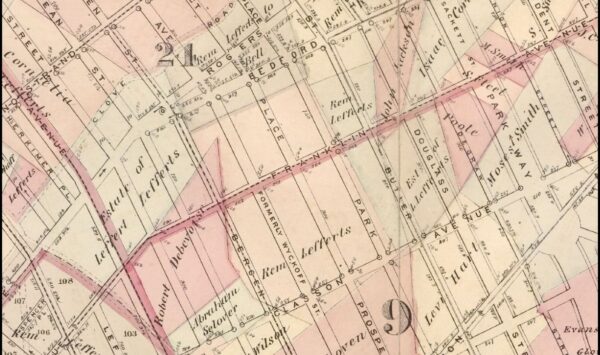
******************************************************************************************************************************** Brownstone Detectives investigates the history of our clients’ homes. The story you are about to read was composed from research conducted in the course of one of those investigations. Do you know the history of YOUR house? ******************************************************************************************************************************** Brooklyn was once one giant farm. At some point, as the farms began to be split up to be sold to developers – those who wanted to build rows of prized brownstones – companies also began to pop up which developed maps showing what types of buildings existed on every “lot” within the city. Although no longer used for fire insurance purposes, they are great tools for those owners wishing to research the histories of their properties. If you own a home in New York City, these maps can help you to determine how old it is, what else had been built in the area when your house was new, and, on some maps, the name of the farmer that had once owned your land. Find yours HERE. Follow @BrownstoneDetec Share ———————————————————————————————————————– The Brownstone Detectives Brownstone Detectives is an historic property research agency. Our mission is to document and save the histories of our clients’ homes. From our research, we produce our celebrated House History Books and House History Reports. Contact us today to begin discovering the history of your home.
THE BUSHWICK WHEELMEN CLUBHOUSES (1894)
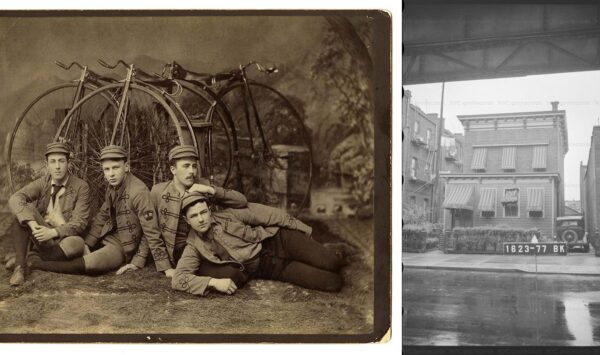
******************************************************************************************************************************** Brownstone Detectives investigates the history of our clients’ homes. The story you are about to read was composed from research conducted in the course of one of those investigations. Do you know the history of YOUR house? ******************************************************************************************************************************** When the cycling rage began in the early 1890s, Bushwick’s “wheel” enthusiasts joined together under the moniker, the Bushwick Wheelmen. It would not be long before, as with other clubs of the era, that the Wheelmen would find a club house of its own. In 1894, the the club purchased its first Brooklyn clubhouse, No. 841 Lexington Avenue, in today’s Bedford-Stuyvesant section. “The Bushwick Wheelmen have fairly settle in their new club house, at 841 Lexington avenue,” noted the Brooklyn Citizen in 1894. “Their membership list numbers about one hundred, and the financial condition of the club is excellent.” “An opening reception was held on Wednesday night and it proved a very enjoyable affair,” reported the Brooklyn Daily Eagle. “The club house was decorated and a large company of women were present. “At 11 P. M. a collation was served.” Throughout the next few years, numerous meetings, parties, and euchres were held in the 2-story wood-frame house. Around 1897, the house was sold to a private family and the club moved its clubhouse to “the corner of Bushwick avenue and Harman street,” No. 897 Bushwick Avenue. “It is situated in one of the choicest residential sections of the city,” said the Times Union. “The building is a three-story and basement structure, […]
PATRONAGE & PLUMS, No. 398 HENRY ST (1895)
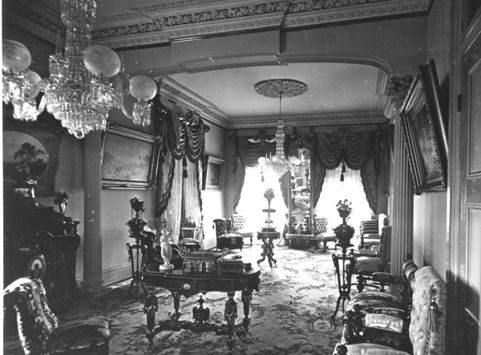
********************************************************************************************************************************Brownstone Detectives investigates the history of our clients’ homes.The story you are about to read was composed from research conducted in the course of one of those investigations.Do you know the history of YOUR house?******************************************************************************************************************************** “The house is a three-story and basement structure. As it is now, the basement is transformed into a pool and billiard room, and from the cellar to the roof the premises are heated. The parlor, of course, comprise the second floor. There is an expanse of Brussels carpet which covers the entire space; in the rear parlor is a business desk, and in the front of it the president’s seat, for the parlors comprise the meeting room of the association and from four to five hundred people can easily be accommodated. Specials chairs are provided when a meeting is to be held, but on other occasions the members are allowed to utilize the furniture for their own comfort. There is not an upholstered chair on this floor which is not an easy one; there is not a lounge or sofa which is not inviting. The walls are papered tastefully, the oil paintings which hand upon them are masterpieces of art and good judgment. The ornamental fireplaces are surmounted with open cabinet work, in the sections of which are enshrined choice bric-a-brac. “Between the front parlor windows hangs the picture of the ward leader, ex-Register James Kane. On the southern wall is the crayon resemblance of Peter Fagan, one of Mr. Kane’s closest friends, and who […]
THE TERRORS OF ST. FELIX ST. (1898)
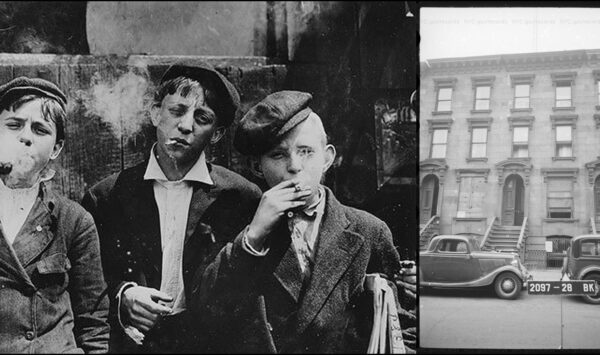
********************************************************************************************************************************Brownstone Detectives investigates the history of our clients’ homes.The story you are about to read was composed from research conducted in the course of one of those investigations.Do you know the history of YOUR house?******************************************************************************************************************************** Harry, Marx and Jacob Hefter, aged 10, 12 and 14 years, were arraigned in the Myrtle Avenue Court this morning. Mrs. Louisa Selover, of 28 St. Felix street, was the complainant against the lads. She said they pelted her with snowballs on the street yesterday and also called her unspeakable names. She stated she had only recently moved onto the street, and that a lady neighbor told her the prisoners were “the terrors of St. Felix street.” The youngster denied the annoyance charged. “The three youngsters,” noted the Brooklyn Citizen, had “decidedly Hebraic countenances,” and “Mrs. Selova was an excitable little woman” who “told her story with a good deal of trepidation.” The Magistrate gravely warned the boys about converting pedestrians into targets for snowballing and sent them home. “They live,” noted the newspaper, “at 17 St. Felix Street.” Follow @BrownstoneDetec Share ———————————————————————————————————————– The Brownstone Detectives Brownstone Detectives is an historic property research agency. Our mission is to document and save the histories of our clients’ homes. From our research, we produce our celebrated House History Books and House History Reports. Contact us today to begin discovering the history of your home.
PAINTING THE HUDSON AT No. 75 ST. JAMES PL
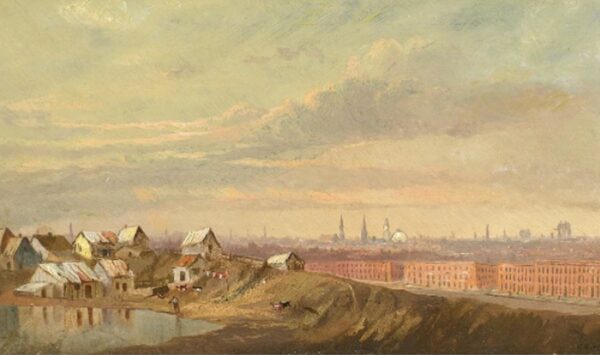
******************************************************************************************************************************** Brownstone Detectives investigates the history of our clients’ homes. The story you are about to read was composed from research conducted in the course of one of those investigations. Do you know the history of YOUR house? ******************************************************************************************************************************** Charles Day Hunt was a talented landscape painter whose work pivoted between the naturalism of the Hudson River School and the expressionism of the Tonalists. Born in Detroit, Michigan, in 1840, he eventually settled in Brooklyn, New York, around 1858 and trained under the landscape painters of the day: John F. Kensett and Alexander Wyant. Hunt’s exhibitions of oil and water color works took place from his studio at No. 75 St. James Place in Clinton Hill section of Brooklyn. Hunt’s work seamlessly blends the influences of both of his mentors in an individual style of crisp brilliance and atmospheric moodiness. Beginning in 1866 going through 1886, Hunt exhibited many times at The National Academy of Art & Design and The Brooklyn Academy of Art. He gained prominence as a member of The Black & White Club, which was a private American art association. Hunt died in 1914 in Brooklyn where, in his studio, his funeral was held. The body lay “beside the empty studio chair, pulled up before the easel,” noted the Brooklyn Daily Eagle, “on which was the picture Mr. Hunt had been working on before his seizure; the palette and oil colors were still wet.” Today, his works can be found in private and public collections, including The Brooklyn Museum […]
No. 4 EAST 78th ST, UES: A BRIEF HISTORY
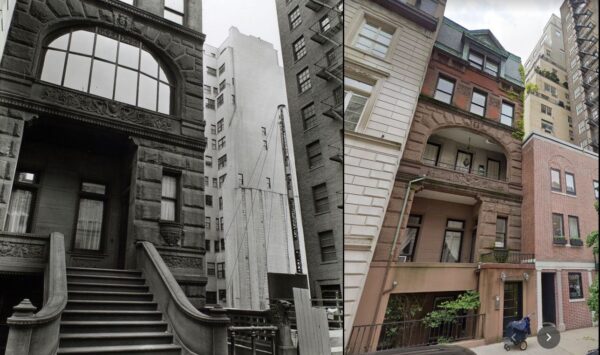
******************************************************************************************************************************** Brownstone Detectives investigates the history of our clients’ homes. The story you are about to read was composed from research conducted in the course of one of those investigations. Do you know the history of YOUR house? ******************************************************************************************************************************** According to Christopher Gray’s Streetscapes: Reader’s Questions, of the New York Times, No. 4 East 78th Street, is a Queen Anne-style house “built in 188 by the developer-architect Edward Kilpatrick. Upon completion, Kilpatrick sold it to the family of Arnold Falk, then living in a rowhouse at 129 East 64th. Mr. Falk was in the tobacco business on Water Street with his brother, Gustav, who lived in an adjacent house, 131 East 64th. On East 78th, Mr. Falk lived with his wife, Fannie, their two children and four servants. In the 1910’s and the 1920’s the house was occupied by the family of Jacob Dreicer, a principal in the Dreicer & Company jewelry firm founded in 1869, which was prominent in this period. There are now seven apartments in the building.” (New York Times, Sunday, 2 June 1991) Follow @BrownstoneDetec Share ———————————————————————————————————————– The Brownstone Detectives Brownstone Detectives is an historic property research agency. Our mission is to document and save the histories of our clients’ homes. From our research, we produce our celebrated House History Books and House History Reports. Contact us today to begin discovering the history of your home.
YOUR BROWNSTONE WAS NOT BUILT IN 1899
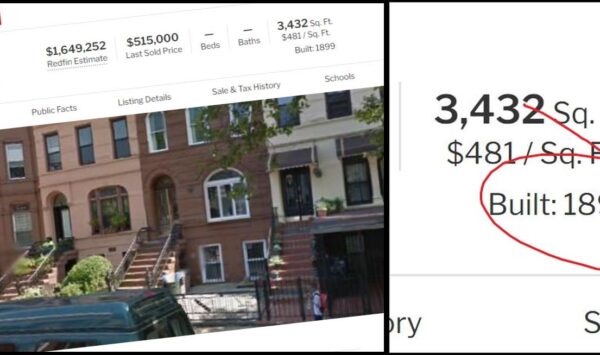
******************************************************************************************************************************** Brownstone Detectives investigates the history of our clients’ homes. The story you are about to read was composed from research conducted in the course of one of those investigations. Do you know the history of YOUR house? ******************************************************************************************************************************** We’ve all “Googled” ourselves, right? But have you ever Googled your house? Most people do this out of curiosity – just to see what might pop up. If you’ve ever done it, though, you were likely greeted with an extensive list of real estate sites that literally entreated you to click their links. Click on one of them and you may be surprised at what you find. Apparently, using their fancy algorithms, these sites can tell you nearly every detail under the sun about your property. These details include: the number of stories your house has, how many units are inside, the legal type of building it is, the district it lies within, its floor plans, the name of its neighborhood, its estimated value, various documents and permits filed, past sales, rental – and the list goes on and on… You may possibly even see images of the exterior of your rowhouse, as well as numerous snapshots of the inside (likely from a previous sale). For the most part you may note that everything – so far as you can tell – is relatively correct. There is, however, one very important piece of information that, on 99% of informational listings (including yours), is dead wrong… “BUILT IN 1899”? Why does nearly […]
THE STRAY PATH OF A BROOKLYN BULLET (1894)
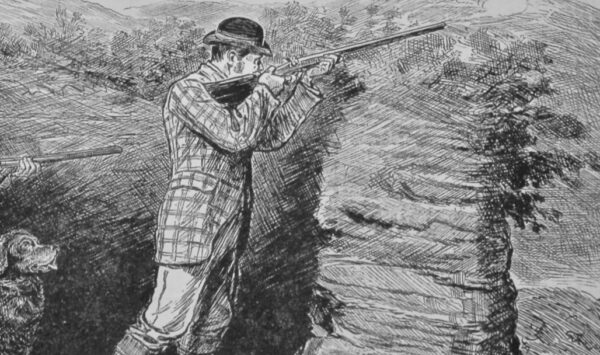
******************************************************************************************************************************** Brownstone Detectives investigates the history of our clients’ homes. The story you are about to read was composed from research conducted in the course of one of those investigations. Do you know the history of YOUR house? ******************************************************************************************************************************** Henry J. Hartig was no law-breaker. As a machinist, he had invented one of the first successful gas engines and patented numerous governor designs over his lifetime. An industrious German-born American citizen, well-known and loved throughout his Fort Greene neighborhood, Hartig was a law-abiding family man who would go on to sire five children with his wife, Emma. He started the Hartig Standard Gas Engine Company, manufacturing his engines – which used illuminating gas for fuel – from the early 1890s and well into the 20th century. And so, possessing the intense interest in creating, tinkering and experimenting that drives all serious inventors, his hunger for learning drew him into a variety of fields that sparked his interest. One of them was guns. Hartig owned at least one firearm – a Flobert Remington “Cadet” .22 rifle – with which he enjoyed taking target practice in his backyard. But when a stray bullet from that weapon struck an innocent man one lazy summer afternoon, it looked as though Hartig would lose it all. “CULLOM WAS HALF ASLEEP WHEN HE FELT A SHARP TWINGE…” Of course it was an accident, and many Brooklynites were owners of firearms in the 1890s – it was that kind of place back then. But then again, the […]
WHEN SARATOGA AVENUE WAS YOUNG (1899)
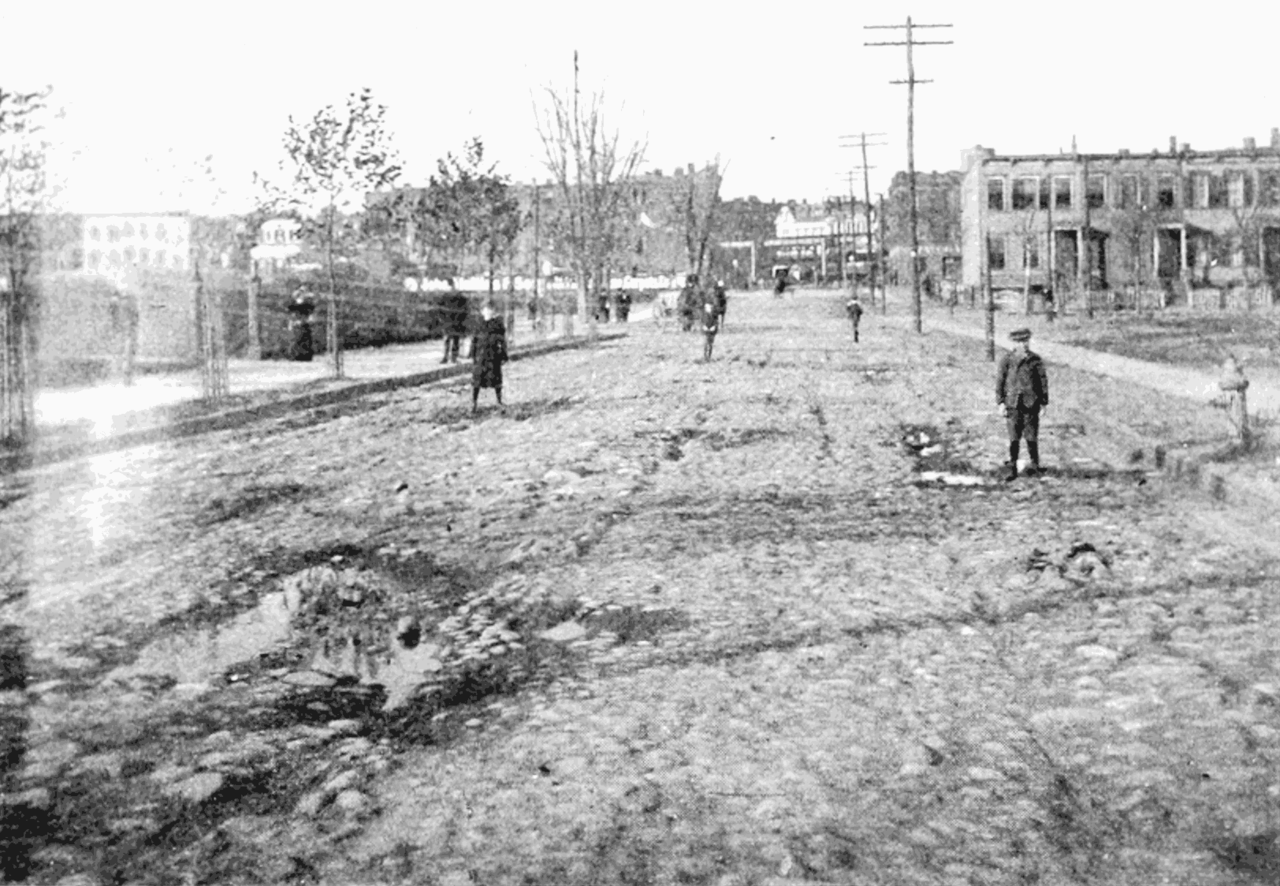
******************************************************************************************************************************** Brownstone Detectives investigates the history of our clients’ homes. The story you are about to read was composed from research conducted in the course of one of those investigations. Do you know the history of YOUR house? ******************************************************************************************************************************** We’d never seen this 1899 picture before – the cobblestones of Saratoga Avenue – taken from Macon Street looking north. To the left you see the gates of the 3-year old Saratoga Square Park and to the right, what was known then as Saratoga Field. A few years before this shot was taken, you would have seen the circus and the various Wild West shows of the time camping out on these two blocks, attracting crowds of people from miles around to the neighborhood. In the distance, you can see the elevated Brooklyn Rapid Transit track, known around this time as the Broadway Elevated, which had opened in 1893 and was a 2-track line at the time. That’s right – no express! And staring back at you are some of the folks who lived and played in the area. It appears from the shot that they were positioned by the photographer. They’re all standing still and upright. Across the street from the park (on the right side of the photograph) would soon be built the Arcadia Dancehall, a “modern dancehall for working girls,” where the modern dances of the day – such as the Bunny Hug and the Tango – were forbidden. Vice President Calvin Coolidge and Teddy Roosevelt’s son, Theodore, […]